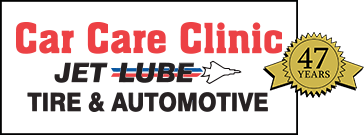Because basic maintenance can go a long way toward improving the safety and dependability of your vehicle, every April is designated as National Car Care Month to encourage owners to give their cars some extra attention.
Results of community car care events held throughout the country show that most consumers neglect simple maintenance of their cars, with seven out of 10 vehicles failing at least one component of the vehicle inspection process.
“Neglected vehicle care almost always means much higher costs down the line in the form of more extensive repairs or lost resale value,” said Rich White, executive director, Car Care Council. “Chances are if you own a car, it needs some work. National Car Care Month in April is the perfect time to focus on your vehicle’s maintenance needs.”
Each year, Car Care Clinic Jet Lube joins with the Car Care Council in recommending the following 10 basic maintenance procedures to keep your car operating at its best:
1) Check the oil, filters and fluids. Oil should be checked at every fill-up and changed per the owner’s manual recommended intervals. Brake, transmission, power steering, coolant and windshield washer fluids should also be checked regularly. Your car’s filters, including those for the transmission, fuel system and interior ventilation, need regular inspection and replacement.
2) Inspect hoses at each oil change and have them replaced when leaking, brittle, cracked, rusted, swollen or restricted. Check V-belts and serpentine belts for looseness and condition, and have them replaced when cracked, frayed, glazed or showing signs of excessive wear. Typically replace the timing belt between 60,000 and 90,000 miles or the interval specified in the owner’s manual to avoid a breakdown or serious engine damage.
3) Check the brake system every year and have the brake linings, rotors, and drums inspected at each oil change.
4) Check that the battery connections are clean, tight, and corrosion-free. The battery should be securely mounted. If it is three years old or more, the battery should be tested and replaced if necessary.
5) Inspect the exhaust system for leaks, damage, and broken supports or hangers if there is an unusual noise. Exhaust leaks can be dangerous and must be corrected without delay.
6) Schedule a tune-up that will help the engine deliver the best balance of power and fuel economy and produce the lowest level of emissions.
7) Check the car’s heating, ventilating, and air conditioning (HVAC) system. Proper heating and cooling performance is critical for interior comfort and for safety reasons, such as defrosting.
8 ) Inspect the steering and suspension system annually, including shock absorbers and struts, and chassis parts, such as ball joints, tie rod ends and other related components.
9) Check the pressure of all tires, including the spare, at least once a month. Check the tread for uneven or irregular wear and cuts and bruises along the sidewalls. Maintaining proper tire pressure can also ensure your vehicle’s best fuel economy, as well ensure safe handling while driving. Have your car’s alignment checked at least annually to reduce tire wear and improve fuel economy and handling.
10) Test exterior and interior lights and have bulbs that are not working checked immediately. Replace windshield wiper blades every six months or when cracked, cut, torn, streaking or chattering for optimum wiping performance and safety.
There’s absolutely no downside to taking care of our cars. Emergency visits to the vet or to see a sick relative are stressful enough already without having automotive problems to deal with. On top of that, taking care of your vehicle helps keep the resale values up.
Learn more about the Car Care Council at www.carcare.org.


